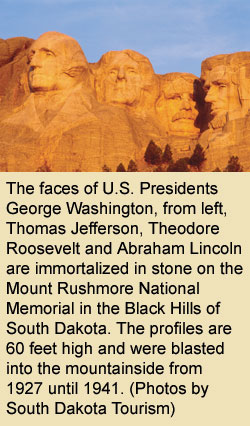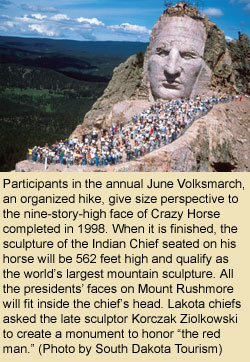South Dakota is home to
Mount Rushmore and Crazy Horse
By Patricia Happel Cornwell
 SOUTH DAKOTA—A popular comedian says you might live in South Dakota “if you have ever worn shorts and a parka at the same time.” You also might live there “if you design your kid’s Halloween costume to fit over a snowsuit.”
SOUTH DAKOTA—A popular comedian says you might live in South Dakota “if you have ever worn shorts and a parka at the same time.” You also might live there “if you design your kid’s Halloween costume to fit over a snowsuit.”
South Dakota is one of those wide-open spaces that drivers call a “dial tone” unless they have a really good reason to stop there.
We have a really good reason. Our daughter lives there. With our son-in-law as a guide, we have discovered that the state is bursting at the seams with history, if not residents.
The majority of South Dakota’s landscape is treeless plains where wild antelope and bison graze—really! Gas stations and towns are few and far between; big farms abound. The state is more than twice the size of Indiana, but has one-eighth the inhabitants—on average 10 people per square mile. The population includes 60,000 Native Americans and three members of our family.
In South Dakota, you can go antiquing, bicycling, bird-watching, boating, camping, fishing, ice-fishing, golfing, hiking, hunting, horseback-riding, snowmobiling or skiing—snow or water—they have lots of both. You can round up buffalo, photograph butterflies, dig for fossils or casino-hop. You can eat Indian fry bread on a reservation or wine and dine at Minerva’s in Sioux Falls. You can enjoy traditional Native American dancing or a polka festival.
If people know anything about South Dakota, they remember that it is home to the Mount Rushmore National Monument, where 60-foot high profiles of George Washington, Thomas Jefferson, Abraham Lincoln and Theodore Roosevelt were blasted into a mountainside from 1927 until 1941. When we saw the monument three years ago, a bank of purple clouds suddenly enveloped the great men’s heads, and a magnificent storm reminded us that nature remains untamed.
A short drive from Rushmore is Crazy Horse, the world’s largest mountain sculpture in progress. When finished, it will be 641 feet long by 562 feet high, and all of Rushmore’s faces will fit inside the chief’s head. After Rushmore was begun, Lakota chiefs asked sculptor Korczak Ziolkowski for a monument “to let the white man know the red man has great heroes, too.”
A Catholic with 10 children, Ziolkowski worked on it from 1947 until his death in 1982. In 1983, his family presented Pope John Paul II with a bronze model. In 1998, the nine-story chief’s face was completed and work began on the
22-story horse’s head. The site includes the Indian Museum of North America. A 10-kilometer Volksmarch (hike) up the mountain occurs every June.
 Crazy Horse has a peculiar Hoosier connection. In 1991,Lloyd Duggins of Mauckport, who had never visited the monument, bequeathed $230,000 for it—the largest gift in its history.
Crazy Horse has a peculiar Hoosier connection. In 1991,Lloyd Duggins of Mauckport, who had never visited the monument, bequeathed $230,000 for it—the largest gift in its history.
Anchored by Rapid City, the western sector also boasts the surreal moonscape of Badlands National Park, Black Hills National Forest and Black Hills Caves. Custer State Park in the Black Hills has one of the world’s largest bison herds. In October, the public saddles up to help park crews round up the 1,500 behemoths.
Deadwood capitalizes on its frontier past—Wild Bill Hickok and Calamity Jane—and attracts gamers to 80 casinos. The entire city is a National Historic Landmark. Its 19th-century Chinatown section is undergoing archaeological
excavation, and the HBO cable TV series “Deadwood” depicts the town’s gold rush days.
East of Rapid City is Wall Drugs, a story—and destination—in itself. When Ted and Dorothy Hustead opened a drug store in Wall in 1931, the 326 residents weren’t enough to support it. Still, the couple was determined to raise their children in a small town with a Catholic church where they could go to Mass daily.
In July 1936, Dorothy suggested they post signs along the highway, advertising “Free Ice Water” to jalopies rumbling by en route to Mount Rushmore and Yellowstone Park. It worked. Today, the store is bigger than the town. Over the years, signs noting how far it is to Wall Drugs have been posted across the U.S. and as far away as Paris, Moscow and even the South Pole.
Museums in several cities offer windows onto South Dakota’s archaeological and cultural development. Several state-run sites let volunteers sift for fossils of extinct creatures or for artifacts at prehistoric Indian villages.
“Sue,” the largest, most complete Tyrannosaurus Rex skeleton ever found, was discovered by an amateur fossil hunter near Faith in 1990. The massive dinosaur skeleton is now on display in Chicago’s Field Museum.
In eastern South Dakota, Fort Sisseton State Park is one of the nation’s best-preserved frontier forts. Each June, a festival features cavalry drills, a military costume ball and a living history encampment.
South of Sisseton, a footbridge now spans Devil’s Gulch, the chasm that Jesse James leapt on horseback to elude a posse.
Two miles farther, the 50-foot cliffs of Palisades State Park border Split Rock Creek, where wildflowers abound and geese fly down the canyon corridor like Star Wars star-fighters.
“Little House on the Prairie” fans will enjoy visiting the Ingalls’ 1880s farm at DeSmet, which has a “Little House” pageant in June and July.
In Aberdeen, literary figures including Mother Goose and The Wizard of Oz author, Aberdeen native L. Frank Baum, are featured at Wylie Park Storybook Land. With its castle, carousel and train, this is a fun place for young children.
Sioux Falls hosts the Northern Plains Tribal Arts Festival each September. The parks department’s Outdoor Campus and Great Bear Recreation Park offer year-round nature classes and activities, including snow sports, for all ages.
Sertoma Butterfly House offers a more tropical experience, with special hours just for photographers. At the city’s Great Plains Zoo, our granddaughter’s favorite animal is the pink Chilean flamingo. The zoo also has a petting zoo, animal shows, train rides and a carousel for those who prefer their animals tame.
Bedford limestone from southern Indiana found its way into the walls of Sioux Falls’ St. Joseph Cathedral, constructed in 1918. The church’s lovely 1948 stained-glass windows include a cameo of then-living Pope Pius XII at a microphone. Another Indiana “import” was the diocese’s first bishop, Benedictine Father Martin Marty, who also had been Saint Meinrad Archabbey’s first abbot.
Meriwether Lewis’ and William Clark’s Corps of Discovery spent parts of 1804 and 1806 exploring what is today South Dakota. During ongoing commemorations, state parks invite tourists to hike their Lewis and Clark Trail. Several communities plan Lewis and Clark celebrations this summer.
Recreational areas and wildlife refuges abound in the state, which has more than 1,100 square miles of water and a fishing season that never ends. South of Sioux Falls, the Lewis and Clark Recreation Area hugs the Missouri River. A great family place, the park has beaches, cabins, fishing and boating. At Pickerel Lake, my husband and granddaughter found an animal tooth, which an archaeologist at Augustana College in Sioux Falls later identified as a 300-year-old baby buffalo tooth.
South Dakota’s agricultural roots are showing in Mitchell’s Corn Palace, an auditorium decorated in murals of grain—yes, the birds eat it—as well as Carthage’s Straw Bale Built Museum and Roslyn’s International Vinegar Museum, known as “the world’s first and only.” Other towns offer threshing shows, rodeos and a Potato Day. I have yet to find out what a Schmeckfest is.
Sioux Falls, the state’s largest city, lies just inside its eastern border. Flying there requires changing planes at St. Louis, Chicago or Minneapolis. With layovers, it can be quicker to drive. From Indianapolis to Sioux Falls, the drive is 760 miles and from Louisville it is 930 miles. To see the Badlands or get that free ice water from Wall Drugs, add 350 miles.
And in case you’re wondering, South Dakota highways are pink because they are made with native granite. Many public buildings are made of it; our daughter’s home is partially faced with it.
The South Dakota Department of Tourism has a superb website, travelsd.com, or you can call their toll-free number at 800-732-5682. A search for “group tour” then “Indiana” on their website yields eight Hoosier companies offering guided trips to South Dakota. Another good Internet site for campers to log on to is ParkInfo@state.sd.us.
Despite its cultural cornucopia, our favorite South Dakota activity is visiting our family. I still can’t believe our only grandchild lives in a state next door to Wyoming. And, yes, her Halloween costume often involves a snowsuit.
(Patricia Happel Cornwell is a freelance writer and a member of St. Joseph Parish in Corydon.) †
 SOUTH DAKOTA—A popular comedian says you might live in South Dakota “if you have ever worn shorts and a parka at the same time.” You also might live there “if you design your kid’s Halloween costume to fit over a snowsuit.”
SOUTH DAKOTA—A popular comedian says you might live in South Dakota “if you have ever worn shorts and a parka at the same time.” You also might live there “if you design your kid’s Halloween costume to fit over a snowsuit.”  Crazy Horse has a peculiar Hoosier connection. In 1991,Lloyd Duggins of Mauckport, who had never visited the monument, bequeathed $230,000 for it—the largest gift in its history.
Crazy Horse has a peculiar Hoosier connection. In 1991,Lloyd Duggins of Mauckport, who had never visited the monument, bequeathed $230,000 for it—the largest gift in its history.